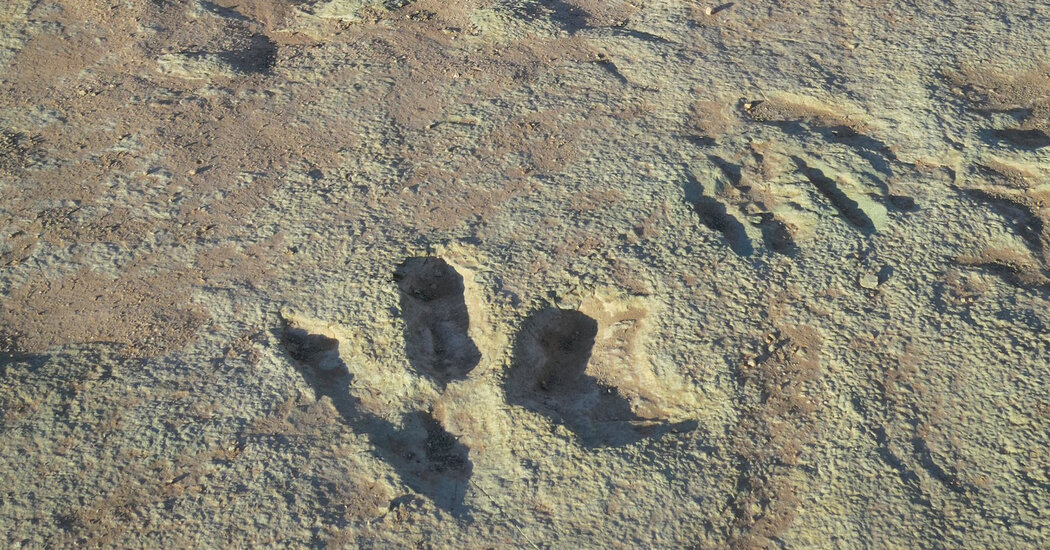Federal work on a new walkway at the site has been halted after paleontology groups raised the alarm about equipment “driven directly over the fossil dinosaur tracks.”
In a stretch of remote scrubland north of Moab, Utah, visitors can walk a path across the same land dinosaurs roamed millions of years ago, and peer down at the footprints and other marks the prehistoric beasts left behind, still visible, though turned to stone.
In recent weeks, however, it’s been the rumble of construction machinery, not the footsteps of giant creatures, that has unsettled the area, known as the Mill Canyon Dinosaur Tracksite, raising urgent questions about how to preserve the fossils under the feet of modern inhabitants.
In the past week, several paleontologists and scientists have called on the Bureau of Land Management to halt work on a new metal and concrete walkway at the site, saying some fossilized footprints had already been damaged by the construction.
Utah Friends of Paleontology, a nonprofit advocacy group that has studied the site, published a statement on Jan. 29 criticizing the bureau’s work, which the group said had not been carried out under the supervision of a paleontologist.
On Tuesday, the Society of Vertebrate Paleontology, a global scientific nonprofit, sent a letter to the bureau’s state director for Utah, Greg Sheehan, saying it feared that “irreparable, and avoidable, damage” had been done — damage that “would have been avoided if qualified paleontologists had been on your staff.”
The Center for Biological Diversity added its voice to the objections this week, laying out the legal basis for the shortcomings in a cease-and-desist letter to Mr. Sheehan. Bureau of Land Management construction equipment — including a backhoe — had been “driven directly over the fossil dinosaur tracks, permanently destroying as much as 30 percent of the site,” the letter said.
Patrick Donnelly, a director at the center who signed the letter, said in an interview on Friday that it was intended to act as a “red flag” for the bureau. “If we were to one day decide to pursue legal action, that would have been the first step,” he said. “They have not necessarily owned up to the damage.”
Mr. Donnelly said that one bureau official, Gary Torres, the Canyon Country district manager, replied to him in an email saying that the bureau would stop work at the site, conduct damage assessment with a paleontologist and work with “communities of interest to see what the long-term vision should be for the trackways.”
A bureau spokeswoman, Rachel Wootton, confirmed on Friday that the agency had halted the work, and that Utah’s state paleontologist, Jim Kirkland, and a regional bureau paleontologist were at the site to make assessments.
“At this time, we have no evidence of any damage in the interpreted area, but out of an abundance of caution, a team will be dispatched to assess,” the statement said.
The Mill Canyon Dinosaur Tracksite is one of the most significant of its kind in the world, according to the Bureau of Land Management. In 2009, the tracks were first reported to the bureau, which erected a fence. Over 200 individual tracks were eventually recorded, the bureau said last year, from at least 10 species of dinosaur — including sickle-clawed raptors and ancient relatives of crocodiles — believed to date back some 112 million years.
In 2015, a raised boardwalk was built at the site, which lies about two miles from a highway. The boardwalk quickly became popular with visitors, according to an October 2021 assessment for the new metal and concrete walkway. The wooden walkway, used by thousands of people every year, had warped, it said. “The trail would ensure that the public would not walk directly on the tracks and would also improve safety,” it said.
“Reconstruction of the walkway has the potential to disturb existing paleontological resources,” the assessment said, referring to special measures, including inspections that had been “imposed to safeguard the paleontological resource.”
“There would be no risk to the trackway from construction activities,” it said.
The group of the experts who prepared the assessment did not include a paleontologist. Instead, a Bureau of Land Management geologist was charged with assessing the paleontology aspects of the project.
The first concern about work at the site emerged last week, when Susan Sternberg, a former volunteer steward at Mill Canyon, saw the tractor at the site and contacted Lee Shenton, president of the Moab chapter of Utah Friends of Paleontology, Mr. Shenton said in an interview on Friday.
Mr. Shenton and other experts seized on the lack of input from a paleontologist, although the extent of any damage to the fossils was not yet immediately clear.
“There is damage and there is no reason there should be any damage,” Dr. Kirkland, the state paleontologist, said after visiting the site on Sunday, according to a Deseret News report. “It is not completely destroyed as some people were suggesting, but I was pretty scared.”
Mr. Shenton, who has previously helped document the footprints, said that when he visited the site this week, the boardwalk, which had generally been in the shape of a horseshoe, had been torn up and set aside near a tractor, which was fitted with a backhoe, and a forklift that was parked nearby. He saw tire tracks in layers of soil that he knew covered ichnofossils, which are fossilized traces of biological activity.
Those include footprints left by three-toed theropods and long-necked sauropods, as well as marks of the scales or dragged tails of ancient relatives of crocodiles. Such marks can be “hard and brittle,” Mr. Shenton said. They can also break easily, such as when a frost occurs, in bad weather, when a person steps on it, or when surrounding dirt is displaced, he added.
“There was no doubt” some damage had occurred, he said. But its extent was “not immediately recognized.”


























